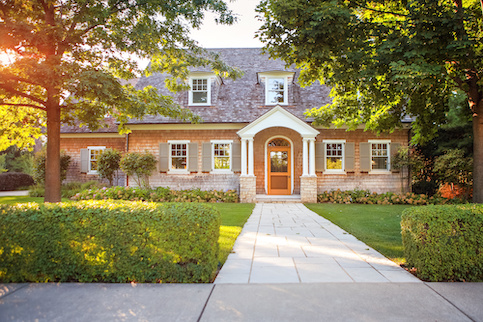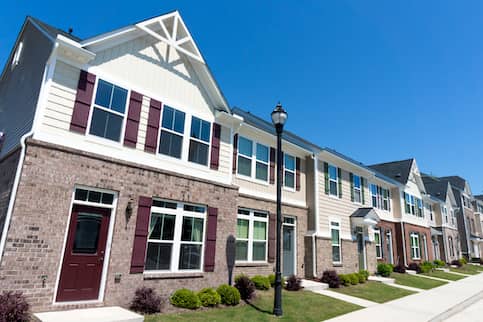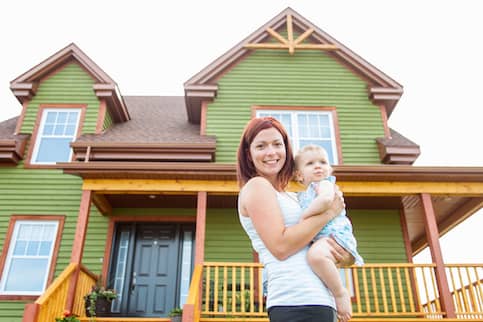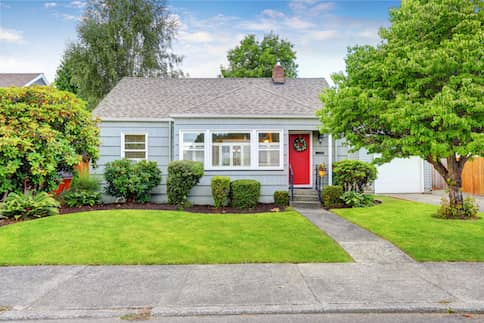Down Payment Assistance: How It Works And How To Find A Program For You

There are many steps to buying a home, but coming up with a down payment can be the biggest obstacle. For some buyers who would otherwise be able to comfortably afford the monthly payment, a down payment could stop them from purchasing a home. However, there’s hope. Down payment assistance programs may be able to provide the relief you need.
Key Takeaways:
- Nonprofits, government agencies and other organizations offer down payment assistance programs to help first-time home buyers afford the upfront costs.
- A variety of down payment assistance programs are available, each with unique features and benefits. Some require repayment, while others do not, giving you the flexibility to choose the one that best suits your financial situation.
- Down payment assistance can expedite your journey to homeownership, but it’s important to understand the requirements, terms and conditions so you can make an informed decision.
What Is A Down Payment Assistance Program?
Down payment assistance consists of grants, deferred payment loans and forgivable loans offered typically to first-time home buyers to help them afford the down payment and closing costs. Down payment assistance usually is provided by nonprofit organizations, state and local housing finance agencies, municipalities, and mortgage lenders.
Other forms of down payment assistance include low-interest loans, mortgage lender offerings, individual development accounts and matched savings programs.
Take The First Step To Buying A Home
Find a lender that will work with your unique financial situation.
How Does Down Payment Assistance Work?
Applying for down payment assistance is straightforward. You need to apply to the program offering the assistance, which may require information similar to that needed for a mortgage application.
The way individual down payment assistance programs work will vary – sometimes significantly. Some offer assistance that doesn’t need to be paid back, while others need to be repaid like a loan or only under certain circumstances.
Not all mortgage lenders accept all assistance programs, and some programs require you to get your primary mortgage with a specific lender.
Down payment assistance programs that require the primary lien on the home being purchased are unpopular with mortgage lenders because this means the assistance program has first dibs on recovering its losses if the home has to go to foreclosure.
If your lender accepts the assistance and you’re approved, you can use it to make a qualifying down payment and pay the closing costs necessary to afford a home. You also could add it to your savings to make a higher down payment, which may reduce your mortgage rate or help you avoid paying for private mortgage insurance.
What’s Your Goal?
Home Purchase
Home Refinance
Tap Into Equity
Types Of Down Payment Assistance Grants And Programs
If you need down payment assistance, there are plenty of options.
Grants
Grants are desirable because they don’t have to be paid back. Lenders generally accept down payment assistance grants, but you may be required to live in the home as your primary residence for a specific number of years. Grants typically can be used to cover 2% to 5% of the home’s purchase price.
Forgivable Loans
A forgivable loan usually is a second loan large enough to cover the down payment on a home, and you don’t have to repay it as long as you meet certain conditions. For example, you don’t have to repay the loan if you live in the home and pay the primary mortgage for five years. If you were to move out, refinance or sell the home before the five-year mark, you would be required to repay the loan.
Like the other loan options, forgivable loans are usually enforced through a secondary lien on the home.
Deferred Payment Loans
Deferred payment loans take a couple of different forms. One is that the loan doesn’t have to be repaid until the home is sold, refinanced or otherwise paid off. If you have enough equity, you could repay the loan when refinancing or with proceeds from a sale.
In other situations, payments on the loan are delayed for a specific time. Depending on the length of deferment, lenders may include the payment in your debt-to-income ratio, which could affect how much of a loan your lender approves.
Low-Interest Loans
Low-interest loans are similar to deferred payment loans. The difference is that the repayment starts immediately after you close on your loan. For that reason, the payment is included in your DTI ratio. These loans may come from traditional down payment assistance programs or financial institutions.
Mortgage Lender Programs
Individual lenders may have their own down payment assistance options. Typically, these are tied to specific loan products. They often require the buyer to contribute a certain percentage of the purchase price, with the lender contributing the remaining amount.
Mortgage lender down payment assistance programs often are available to current homeowners and first-time buyers. You’ll typically need to use the money to purchase a primary residence and you’ll still need to meet traditional underwriting requirements to qualify.
Matched Savings Programs
Matched savings programs help make it easier to save for a home by matching your savings. This works much like when employers match employee contributions to a retirement plan. You’ll typically open a down payment savings account and then receive contributions from organizations that agree to match your contributions. The matching funds can be used only for a down payment or other qualifying costs.
Individual Development Accounts
Individual development accounts are matched savings programs for lower-income people and families. They typically are funded by the federal or state governments and run by housing finance agencies.
Closing Costs Credits
Some assistance programs help with the other significant upfront expense of buying a home: closing costs. Closing costs include all the fees you pay to get a mortgage and transfer legal ownership of the home. While some closing costs are relatively minor, they average 2% to 5% of the purchase price. Some lenders may waive some closing costs to reduce the amount you pay upfront or roll them into the purchase price, though this often comes with a higher interest rate on your loan.
Discounted Mortgage Rates
A discounted mortgage rate is another type of assistance that can make homeownership more affordable. For example, the Federal Housing Finance Agency offers a First-Time Homebuyer Mortgage Rate discount that could reduce your interest rate by up to 1.75 percentage points. If you take out a $350,000 fixed-rate loan with a 30-year term at a 6% interest rate, your monthly loan payment would be $2,098. Lowering your interest rate by 1.75 percentage points to 4.25%, your monthly payment would be $1,722 – saving you $376 per month.
Property Tax Credits
State and local governments also offer property tax credits to first-time home buyers. For example, a mortgage credit certificate can get you a federal income tax credit of up to $2,000 per year on the mortgage interest you pay on the home. To be eligible, you’ll need to be a first-time home buyer purchasing your primary residence and fall within certain income limits.
Ready To Become A Homeowner?
Get matched with a lender that can help you find the right mortgage.
Down Payment Assistance Program Requirements
Every down payment assistance program has its own requirements. Some are specifically first-time home buyer assistance programs. Others are targeted at low-income home buyers or the middle class. Still others require that you live in a specific location.
The most common type of down payment assistance program is aimed at first-time home buyers. Although the definition may seem self-explanatory, this is actually open to more people than you might think.
Who Qualifies As A First-Time Buyer?
The following are common requirements to qualify as a first-time home buyer:
- You haven’t owned any interest in residential property in the three years before your closing date.
- You’ll be occupying the property as your primary residence.
- You’ll be moving in within 60 days of your closing date.
Depending on the terms of the program, the three-year waiting period may be waived if you’re a single parent with full or joint custody of at least one child. You also may not have to wait if you were a displaced homemaker, defined as someone unemployed, having part-time or inconsistent employment before divorce or separation from their spouse.
If the program follows FHA first-time home buyer requirements, you may be able to avoid waiting if you’ve only owned a primary residence that wasn’t affixed to a permanent foundation. You also qualify if you’ve only owned a property that wasn’t compliant with applicable building codes, and it would cost more to make it compliant than to buy a new home.
Finding Down Payment Assistance Programs And Grants
Down payment assistance can come from many sources. Here’s where to start:
- Department of Housing and Urban Development. HUD is best known to many as the home of the Federal Housing Administration, which administers FHA loans. It also has a directory of local home buying programs, including down payment assistance.
- Housing finance agencies. States and some larger cities have housing finance agencies. These can be great resources for state-supported programs.
- Municipalities. Regardless of whether they do so through a housing finance agency or otherwise, municipalities often have housing support programs in one form or another.
- Housing-focused nonprofits. Nonprofits focused on housing also are good places to look for grants and other forms of down payment assistance.
- Down payment assistance programs for specific groups. There are programs for people who work in particular occupations, such as the Teacher Next Door program. There also are programs for other school employees, nurses and health care professionals, law enforcement and other first responders, government employees, active-duty military, and veterans.
How To Apply For Down Payment Assistance
Some down payment assistance programs – like first-time home buyer tax credits and the FHFA First-Time Home Buyer Mortgage Rate Discount – don’t even require you to apply and can be used automatically. Other down payment assistance programs – like grants and forgivable loans – will require you to apply with the government.
What Types Of Loans Allow Down Payment Assistance Grants Or Programs?
Generally speaking, major mortgage investors such as Fannie Mae, Freddie Mac, the FHA, Veterans Affairs, etc., allow down payment assistance, whether through grants or loans. The thing to watch for is whether the lender has to be approved or the down payment assistance has to be the first lien. If that’s the case, many mortgage lenders won’t accept those programs. Speak with your mortgage lender to learn more.
Pros And Cons Of Down Payment Assistance Programs
Some of the benefits of down payment assistance programs include:
- You can buy a home sooner.
- You can save money on the upfront costs of buying a home.
- You could receive grants or a forgivable loan you don’t need to repay.
- You could get a loan with a 0% interest rate.
- Some loans don’t have to be repaid until you’ve paid off or sold your home.
- You can avoid paying for PMI.
Down payment assistance programs also come with some downsides, such as:
- You could pay more interest over the life of your loan.
- You may need to be a first-time home buyer or meet other eligibility requirements.
- You may need to repay the money if you don’t meet specific terms.
- If the assistance comes as a second mortgage, you may have to repay the loan if you sell or refinance your home.
- Some assistance programs limit the purchase price of the home you can buy.
FAQ
Here are answers to common questions about down payment assistance, how it works and where to find it.
This depends on the type of assistance. Grants do not have to be repaid, and forgivable loans don’t have to be repaid if you meet the requirements for forgiveness. You do have to pay back deferred payment loans according to your agreement, though often not until you sell or refinance your home.
The FHA itself doesn’t offer down payment assistance. However, you can use down payment assistance from a third-party entity or your lender to make the down payment on an FHA loan and pay closing costs.
You can use multiple down payment assistance programs as long as the terms of any down payment assistance you receive don’t prohibit using assistance from other sources. Remember, not all lenders accept all down payment assistance programs.
Generally, down payment assistance is going to be worth it. It could mean the difference between being able to afford a house and continuing to rent. In other cases, you might use the assistance to avoid paying PMI. You just have to know whether the lender will accept it and under what circumstances you might have to pay it back.
It depends on the program and the organization that’s funding it. Do your research to see what down payment assistance programs are offered in your area and which you might be eligible for.
The Bottom Line
Down payment assistance programs provide funds that can be used by home buyers to help with down payment and closing costs on a home, which are often the most significant roadblocks. Down payment assistance is available through grants, deferred loans, forgivable loans and loans that are immediately repayable. Not all lenders accept all forms of down payment assistance. Assistance requiring a lender to be approved or with first-lien restrictions will likely limit your options if you’re shopping around. Many assistance options are targeted at first-time home buyers, but options are available for people who work in the public sector and those whose income is under certain thresholds.
More From Quicken Loans:
Rory Arnold contributed to the reporting of this article.











